TheDeveloperBlog.com
C-Sharp | Java | Python | Swift | GO | WPF | Ruby | Scala | F# | JavaScript | SQL | PHP | Angular | HTML
Python Example
python example - A simple and easy to learn tutorial on various python topics such as loops, strings, lists, dictionary, tuples, date, time, files, functions, modules, methods and exceptions.
First Python ProgramIn this Section, we will discuss the basic syntax of Python, we will run a simple program to print Hello World on the console. Python provides us the two ways to run a program:
Let's discuss each one of them in detail. Interactive interpreter prompt
Python provides us the feature to execute the Python statement one by one at the interactive prompt. It is preferable in the case where we are concerned about the output of each line of our Python program. To open the interactive mode, open the terminal (or command prompt) and type python (python3 in case if you have Python2 and Python3 both installed on your system). It will open the following prompt where we can execute the Python statement and check their impact on the console. 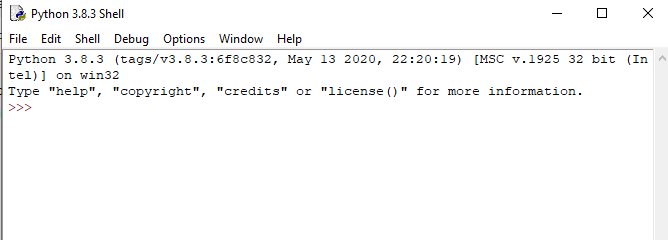
After writing the print statement, press the Enter key. 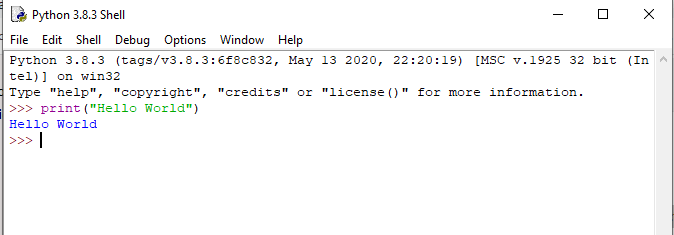
Here, we get the message "Hello World !" printed on the console. Using a script file (Script Mode Programming)
The interpreter prompt is best to run the single-line statements of the code. However, we cannot write the code every-time on the terminal. It is not suitable to write multiple lines of code. Using the script mode, we can write multiple lines code into a file which can be executed later. For this purpose, we need to open an editor like notepad, create a file named and save it with .py extension, which stands for "Python". Now, we will implement the above example using the script mode.
print ("hello world"); #here, we have used print() function to print the message on the console.
To run this file named as first.py, we need to run the following command on the terminal. 
Step - 1: Open the Python interactive shell, and click "File" then choose "New", it will open a new blank script in which we can write our code. 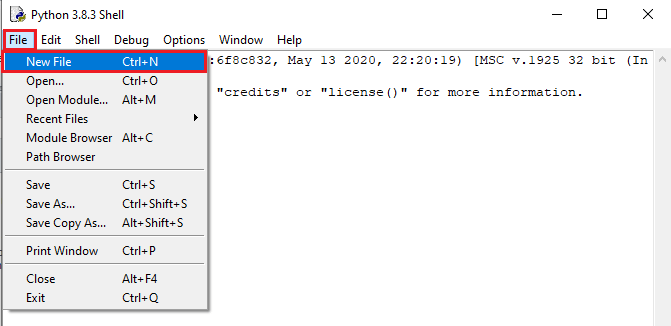
Step -2: Now, write the code and press "Ctrl+S" to save the file. 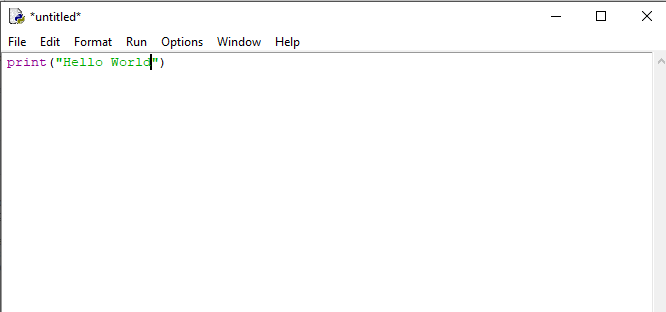
Step - 3: After saving the code, we can run it by clicking "Run" or "Run Module". It will display the output to the shell. 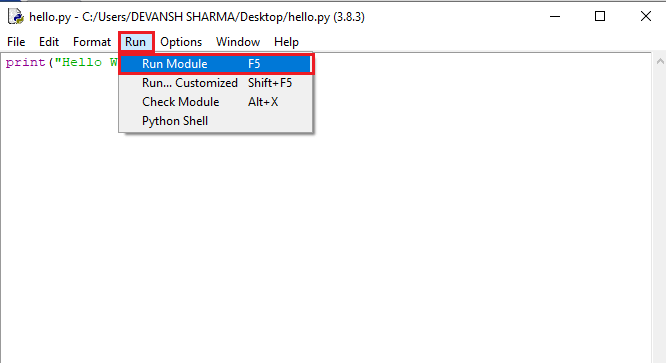
The output will be shown as follows. 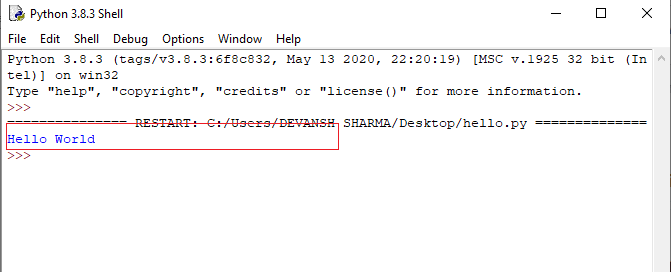
Step - 4: Apart from that, we can also run the file using the operating system terminal. But, we should be aware of the path of the directory where we have saved our file.


Multi-line Statements
Multi-line statements are written into the notepad like an editor and saved it with .py extension. In the following example, we have defined the execution of the multiple code lines using the Python script. Code:
name = "Andrew Venis"
branch = "Computer Science"
age = "25"
print("My name is: ", name, )
print("My age is: ", age)
Script File: 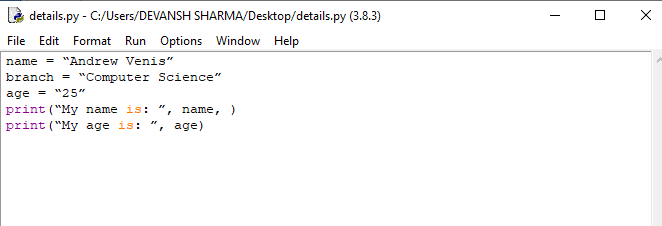

Pros and Cons of Script ModeThe script mode has few advantages and disadvantages as well. Let's understand the following advantages of running code in script mode.
Let's see the disadvantages of the script mode.
Get Started with PyCharmIn our first program, we have used gedit on our CentOS as an editor. On Windows, we have an alternative like notepad or notepad++ to edit the code. However, these editors are not used as IDE for python since they are unable to show the syntax related suggestions. JetBrains provides the most popular and a widely used cross-platform IDE PyCharm to run the python programs. PyCharm installationAs we have already stated, PyCharm is a cross-platform IDE, and hence it can be installed on a variety of the operating systems. In this section of the tutorial, we will cover the installation process of PyCharm on Windows, MacOS, CentOS, and Ubuntu. WindowsInstalling PyCharm on Windows is very simple. To install PyCharm on Windows operating system, visit the link https://www.jetbrains.com/pycharm/download/download-thanks.html?platform=windows to download the executable installer. Double click the installer (.exe) file and install PyCharm by clicking next at each step. To create a first program to Pycharm follows the following step. Step - 1. Open Pycharm editor. Click on "Create New Project" option to create new project. 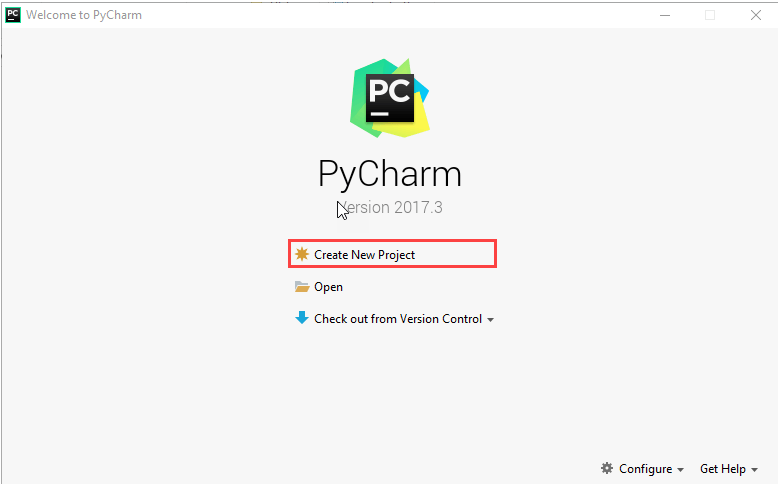
Step - 2. Select a location to save the project.
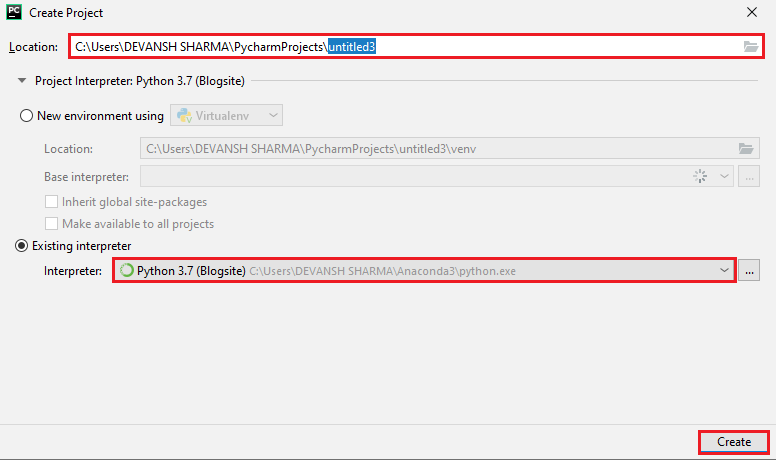
Step - 3. Click on "File" menu and select "New". By clicking "New" option it will show various file formats. Select the "Python File". 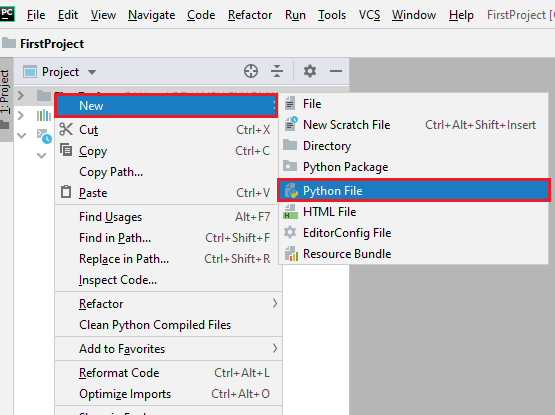
Step - 4. Now type the name of the Python file and click on "OK". We have written the "FirstProgram". 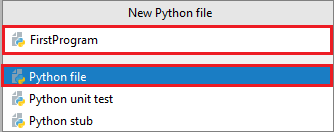
Step - 5. Now type the first program - print("Hello World") then click on the "Run" menu to run program. 
Step - 6. The output will appear at the bottom of the screen. 
Basic Syntax of PythonIndentation and Comment in PythonIndentation is the most significant concept of the Python programming language. Improper use of indentation will end up "IndentationError" in our code. Indentation is nothing but adding whitespaces before the statement when it is needed. Without indentation Python doesn't know which statement to be executed to next. Indentation also defines which statements belong to which block. If there is no indentation or improper indentation, it will display "IndentationError" and interrupt our code. 
Python indentation defines the particular group of statements belongs to the particular block. The programming languages such as C, C++, java use the curly braces {} to define code blocks. In Python, statements that are the same level to the right belong to the same block. We can use four whitespaces to define indentation. Let's see the following lines of code. Example -
list1 = [1, 2, 3, 4, 5]
for i in list1:
print(i)
if i==4:
break
print("End of for loop")
Output: 1 2 3 4 End of for loop Explanation: In the above code, for loop has a code blocks and if the statement has its code block inside for loop. Both indented with four whitespaces. The last print() statement is not indented; that's means it doesn't belong to for loop. Comments in PythonComments are essential for defining the code and help us and other to understand the code. By looking the comment, we can easily understand the intention of every line that we have written in code. We can also find the error very easily, fix them, and use in other applications. In Python, we can apply comments using the # hash character. The Python interpreter entirely ignores the lines followed by a hash character. A good programmer always uses the comments to make code under stable. Let's see the following example of a comment. name = "Thomas" # Assigning string value to the name variable We can add comment in each line of the Python code. Fees = 10000 # defining course fees is 10000 Fees = 20000 # defining course fees is 20000 It is good idea to add code in any line of the code section of code whose purpose is not obvious. This is a best practice to learn while doing the coding. Types of CommentPython provides the facility to write comments in two ways- single line comment and multi-line comment. Single-Line Comment - Single-Line comment starts with the hash # character followed by text for further explanation. # defining the marks of a student Marks = 90 We can also write a comment next to a code statement. Consider the following example. Name = "James" # the name of a student is James Marks = 90 # defining student's marks Branch = "Computer Science" # defining student branch Multi-Line Comments - Python doesn't have explicit support for multi-line comments but we can use hash # character to the multiple lines. For example - # we are defining for loop # To iterate the given list. # run this code. We can also use another way. " " " This is an example Of multi-line comment Using triple-quotes " " " This is the basic introduction of the comments. Visit our Python Comment tutorial to learn it in detail. Python IdentifiersPython identifiers refer to a name used to identify a variable, function, module, class, module or other objects. There are few rules to follow while naming the Python Variable.
Let's understand the following example. Example - number = 10 print(num) _a = 100 print(_a) x_y = 1000 print(x_y) Output: 10 100 1000 We have defined the basic syntax of the Python programming language. We must be familiar with the core concept of any programming languages. Once we memorize the concepts as mentioned above. The journey of learning Python will become easier. CentOSTo install PyCharm on CentOS, visit the link https://www.TheDeveloperBlog.com/how-to-install-pycharm-on-centos. The link will guide you to install PyCharm on the CentOS. MacOSTo install PyCharm on MacOS, visit the link https://www.TheDeveloperBlog.com/how-to-install-pycharm-on-mac. The link will guide you to install PyCharm on the MacOS. UbuntuTo install PyCharm on Ubuntu, visit the link https://www.TheDeveloperBlog.com/how-to-install-pycharm-in-ubuntu. The link will guide you to install PyCharm on Ubuntu.
Next TopicPython Variables
|
Related Links:
- Python global and nonlocal
- Python not: If Not True
- Python Convert Decimal Binary Octal and Hexadecimal
- Python Tkinter Scale
- Python Tkinter Scrollbar
- Python Tkinter Text
- Python History
- Python Number: random, float and divmod
- Python Tkinter Toplevel
- Python Tkinter Spinbox
- Python Tkinter PanedWindow
- Python Tkinter LabelFrame
- Python Tkinter MessageBox
- Python Website Blocker
- Python Console Programs: Input and Print
- Python Display Calendar
- Python Check Number Odd or Even
- Python readline Example: Read Next Line
- Python Anagram Find Method
- Python Any: Any Versus All, List Performance
- Python Filename With Date Example (date.today)
- Python Find String: index and count
- Python filter (Lambda Removes From List or Range)
- Python ASCII Value of Character
- Python Sum Example
- Python make simple Calculator
- Python Add Two Matrices
- Python Multiply Two Matrices
- Python SyntaxError (invalid syntax)
- Python Transpose Matrix
- Python Remove Punctuation from String
- Python Dictionary items() method with Examples
- Python Dictionary keys() method with Examples
- Python Textwrap Wrap Example
- Python Dictionary popitem() method with Examples
- Python Dictionary pop() method with Examples
- Python HTML: HTMLParser, Read Markup
- Python Tkinter Tutorial
- Python Array Examples
- Python ord, chr Built Ins
- Python Dictionary setdefault() method with Examples
- Python Dictionary update() method with Examples
- Python Dictionary values() method with Examples
- Python complex() function with Examples
- Python delattr() function with Examples
- Python dir() function with Examples
- Python divmod() function with Examples
- Python Loops
- Python for loop
- Python while loop
- Python enumerate() function with Examples
- Python break
- Python continue
- Python dict() function with Examples
- Python pass
- Python Strings
- Python Lists
- Python Tuples
- Python Sets
- Python Built-in Functions
- Python filter() function with Examples
- Python dict Keyword (Copy Dictionary)
- Python Dictionary Order Benchmark
- Python Dictionary String Key Performance
- Python 2D Array: Create 2D Array of Integers
- Python Divmod Examples, Modulo Operator
- bin() in Python | Python bin() Function with Examples
- Python Oops Concept
- Python Object Classes
- Python Constructors
- Python hash() function with Examples
- Python Pandas | Python Pandas Tutorial
- Python Class Examples: Init and Self
- Python help() function with Examples
- Python IndentationError (unexpected indent)
- Python Index and Count (Search List)
- Python min() function with Examples
- Python classmethod and staticmethod Use
- Python set() function with Examples
- Python hex() function with Examples
- Python id() function with Examples
- Python sorted() function with Examples
- Python next() function with Examples
- Python Compound Interest
- Python List insert() method with Examples
- Python Datetime Methods: Date, Timedelta
- Python setattr() function with Examples
- Python 2D List Examples
- Python Pandas Data operations
- Python Def Methods and Arguments (callable)
- Python slice() function with Examples
- Python Remove HTML Tags
- Python input() function with Examples
- Python enumerate (For Index, Element)
- Python Display the multiplication Table
- Python int() function with Examples
- Python Error: Try, Except and Raise
- Python isinstance() function with Examples
- Python oct() function with Examples
- Python startswith, endswith Examples
- Python List append() method with Examples
- Python NumPy Examples (array, random, arange)
- Python Replace Example
- Python List clear() method with Examples
- Python List copy() method with Examples
- Python Lower Dictionary: String Performance
- Python Lower and Upper: Capitalize String
- Python Dictionary Examples
- Python map Examples
- Python Len (String Length)
- Python Padding Examples: ljust, rjust
- Python Type: setattr and getattr Examples
- Python String List Examples
- Python String
- Python Remove Duplicates From List
- Python If Examples: Elif, Else
- Python Programs | Python Programming Examples
- Python List count() method with Examples
- Python List extend() method with Examples
- Python List index() method with Examples
- Python List pop() method with Examples
- Python Palindrome Method: Detect Words, Sentences
- Python Path: os.path Examples
- Python List remove() method with Examples
- Python List reverse() method with Examples
- Top 50+ Python Interview Questions (2021)
- Python List sort() method with Examples
- Python sort word in Alphabetic Order
- abs() in Python | Python abs() Function with Examples
- Python String | encode() method with Examples
- all() in Python | Python all() Function with Examples
- any() in Python | Python any() Function with Examples
- Python Built In Functions
- ascii() in Python | Python ascii() Function with Examples
- Python bytes, bytearray Examples (memoryview)
- bool() in Python | Python bool() Function with Examples
- bytearray() in Python | Python bytearray() Function with Examples
- Python Caesar Cipher
- bytes() in Python | Python bytes() Function with Examples
- Python Sum of Natural Numbers
- callable() in Python | Python callable() Function with Examples
- Python Set add() method with Examples
- Python Set discard() method with Examples
- Python Set pop() method with Examples
- Python math.floor, import math Examples
- Python Return Keyword (Return Multiple Values)
- Python while Loop Examples
- Python Math Examples
- Python Reverse String
- Python max, min Examples
- Python pass Statement
- Python Set remove() method with Examples
- Python Dictionary
- Python Functions
- Python String | capitalize() method with Examples
- Python String | casefold() method with Examples
- Python re.sub, subn Methods
- Python subprocess Examples: subprocess.run
- Python Tkinter Checkbutton
- Python Tkinter Entry
- Python String | center() method with Examples
- Python Substring Examples
- Python pow Example, Power Operator
- Python Lambda
- Python Files I/O
- Python Modules
- Python String | count() method with Examples
- Python String | endswith() method with Examples
- Python String | expandtabs() method with Examples
- Python Prime Number Method
- Python String | find() method with Examples
- Python String | format() method with Examples
- Python String | index() method with Examples
- Python String | isalnum() method with Examples
- Python String | isalpha() method with Examples
- Python String | isdecimal() method with Examples
- Python Pandas Sorting
- Python String | isdigit() method with Examples
- Python Convert Types
- Python String | isidentifier() method with Examples
- Python Pandas Add column to DataFrame columns
- Python String | islower() method with Examples
- Python Pandas Reading Files
- Python Right String Part
- Python IOError Fix, os.path.exists
- Python Punctuation and Whitespace (string.punctuation)
- Python isalnum: String Is Alphanumeric
- Python Pandas Series
- Python Pandas DataFrame
- Python Recursion Example
- Python ROT13 Method
- Python StringIO Examples and Benchmark
- Python Import Syntax Examples: Modules, NameError
- Python in Keyword
- Python iter Example: next
- Python Round Up and Down (Math Round)
- Python List Comprehension
- Python Collection Module
- Python Math Module
- Python OS Module
- Python Random Module
- Python Statistics Module
- Python String Equals: casefold
- Python Sys Module
- Top 10 Python IDEs | Python IDEs
- Python Arrays
- Python Magic Method
- Python Stack and Queue
- Python MySQL Environment Setup
- Python MySQL Database Connection
- Python MySQL Creating New Database
- Python MySQL Creating Tables
- Python Word Count Method (re.findall)
- Python String Literal: F, R Strings
- Python MySQL Update Operation
- Python MySQL Join Operation
- Python Armstrong Number
- Learn Python Tutorial
- Python Factorial Number using Recursion
- Python Features
- Python Comments
- Python if else
- Python Translate and Maketrans Examples
- Python Website Blocker | Building Python Script
- Python Itertools Module: Cycle and Repeat
- Python Operators
- Python Int Example
- Python join Example: Combine Strings From List
- Python Read CSV File
- Python Write CSV File
- Python Read Excel File
- Python Write Excel File
- Python json: Import JSON, load and dumps
- Python Lambda Expressions
- Python Print the Fibonacci sequence
- Python format Example (Format Literal)
- Python Namedtuple Example
- Python SciPy Tutorial
- Python Applications
- Python KeyError Fix: Use Dictionary get
- Python Resize List: Slice and Append
- Python String | translate() method with Examples
- Python Copy List (Slice Entire List)
- Python None: TypeError, NoneType Has No Length
- Python MySQL Performing Transactions
- Python String | isnumeric() method with Examples
- Python MongoDB Example
- Python String | isprintable() method with Examples
- Python Tkinter Canvas
- Python String | isspace() method with Examples
- Python Tkinter Frame
- Python Tkinter Label
- Python Tkinter Listbox
- Python String | istitle() method with Examples
- Python Website Blocker | Script Deployment on Linux
- Python Website Blocker | Script Deployment on Windows
- Python String | isupper() method with Examples
- Python String split() method with Examples
- Python Slice Examples: Start, Stop and Step
- Python String | join() method with Examples
- Python String | ljust() method with Examples
- Python Sort by File Size
- Python Arithmetic Operations
- Python String | lower() method with Examples
- Python Exception Handling | Python try except
- Python Date
- Python Regex | Regular Expression
- Python Sending Email using SMTP
- Python Command Line Arguments
- Python List Comprehension Examples
- Python Assert Keyword
- Python Set Examples
- Python Fibonacci Sequence
- Python Maze Pathfinding Example
- Python Memoize: Dictionary, functools.lru_cache
- Python Timeit, Repeat Examples
- Python Strip Examples
- Python asyncio Example: yield from asyncio.sleep
- Python String Between, Before and After Methods
- Python bool Use (Returns True or False)
- Python Counter Example
- Python frozenset: Immutable Sets
- Python Generator Examples: Yield, Expressions
- Python CSV: csv.reader and Sniffer
- Python globals, locals, vars and dir
- Python abs: Absolute Value
- Python gzip: Compression Examples
- Python Function Display Calendar
- Python Display Fibonacci Sequence Recursion
- Python String | lstrip() method with Examples
- Python del Operator (Remove at Index or Key)
- Python String | partition() method with Examples
- Python String | replace() method with Examples
- Python Zip Examples: Zip Objects
- Python String | rfind() method with Examples
- Python String | rindex() method with Examples
- Python String rjust() method with Examples
- Python String rpartition() method with Examples
- Python String rsplit() method with Examples
- Python Area Of Triangle
- Python Quadratic Equation
- Python swap two Variables
- Python Generate Random Number
- Python Convert Kilometers to Miles
- Python Convert Celsius to Fahrenheit
- Python Check Number Positive Negative or Zero
- Python Check Leap Year
- Python Check Prime Number
- Top 40 Python Pandas Interview Questions (2021)
- Python Check Armstrong Number
- Python SQLite Example
- Python Tkinter Button
- Python Find LCM
- Python Find HCF
- Python Tuple Examples
- Python String | rstrip() method with Examples
- Python String splitlines() method with Examples
- Python String | startswith() method with Examples
- Python String | swapcase() method with Examples
- Python Truncate String
- Python String | upper() method with Examples
- Python for: Loop Over String Characters
- Python String | zfill() method with Examples
- Python Sort Examples: Sorted List, Dictionary
- Python XML: Expat, StartElementHandler
- Python Urllib Usage: Urlopen, UrlParse
- Python File Handling (with open, write)
- Python Example
- Python variables
- Python Random Numbers: randint, random.choice
- Python assert, O Option
- Python Data Types
- Python keywords
- Python literals
- Python MySQL Insert Operation
- Python MySQL Read Operation
- Python ascii Example
- Python ASCII Table Generator: chr
- Python Range: For Loop, Create List From Range
- Python re.match Performance
- Python re.match, search Examples
- Python Tkinter Menubutton
- Python Tkinter Menu
- Python Tkinter Message
- Python Tkinter Radiobutton
- Python List Examples
- Python Split String Examples


